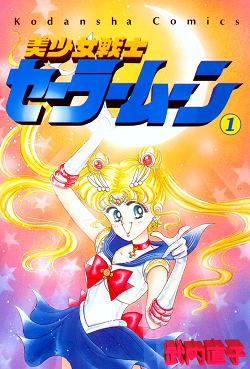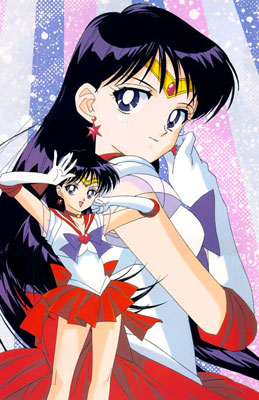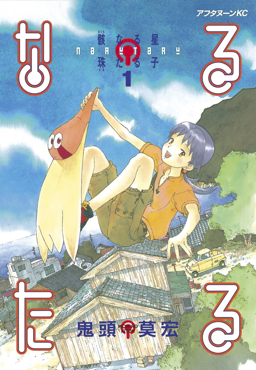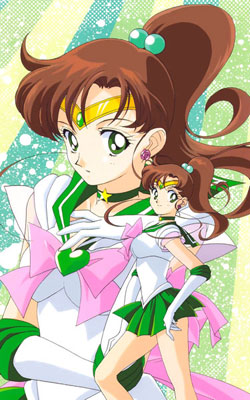Smile was a magazine aimed at teenage girls. The magazine was started in 1998. [1] At first it was supposed to be a mainstream teen mag similar to Seventeen ,[ citation needed ] but with added manga; later, it became more focused on manga and removed most of its other features. It was published by Tokyopop based in Los Angeles.[ citation needed ] The magazine was discontinued in 2002.
Sailor Moon , Peach Girl , and Juline were serialized in the magazine. [2] Sailor Moon was originally serialized in MixxZine but Mixx moved it to Smile because Mixx wanted to refocus MixxZine towards high school and university/college-aged readers. Smile serialized the SuperS story arc, while earlier story arcs not finished in MixxZine were finished in individual comic book publications. [3]

Manga are comics or graphic novels originating from Japan. Most manga conform to a style developed in Japan in the late 19th century, and the form has a long history in earlier Japanese art. The term manga is used in Japan to refer to both comics and cartooning. Outside of Japan, the word is typically used to refer to comics originally published in the country.

Naoko Takeuchi is a Japanese manga artist. She is best known as the author of Sailor Moon, one of the most popular manga series of all time.

Sailor Moon is a Japanese manga series written and illustrated by Naoko Takeuchi. It was originally serialized in Kodansha's shōjo manga magazine Nakayoshi from 1991 to 1997; the 52 individual chapters were published in 18 volumes. The series follows the adventures of a schoolgirl named Usagi Tsukino as she transforms into the eponymous character to search for a magical artifact, the "Legendary Silver Crystal". She leads a group of comrades, the Sailor Soldiers, called Sailor Guardians in later editions, as they battle against villains to prevent the theft of the Silver Crystal and the destruction of the Solar System.

Usagi Tsukino, better known as Sailor Moon, is a Japanese superheroine and the protagonist of the Sailor Moon franchise created by Naoko Takeuchi. She is introduced in chapter No. 1 of the manga, "Usagi – Sailor Moon", as a carefree Japanese schoolgirl who can transform into the magical "Guardian of Love and Justice", Sailor Moon.

Rei Hino, better known as Sailor Mars, is a fictional character in the Sailor Moon manga series written and illustrated by Naoko Takeuchi. In the series, Rei is her sailor form's alternative human identity as part of the Sailor Guardians, female supernatural fighters who protect the Solar System from evil.

Tokyopop is an American distributor, licensor and publisher of anime, manga, manhwa and Western manga-style works. The German publishing division produces German translations of licensed Japanese properties and original English-language manga, as well as original German-language manga. Tokyopop's US publishing division publishes works in English. Tokyopop has its US headquarters near Los Angeles International Airport in Los Angeles, California. Its parent company's offices are in Tokyo, Japan and its sister company's office is in Hamburg, Germany.
Miho Obana is a shōjo manga artist born in Tokyo, Japan. Her best-known work was Kodomo no Omocha, also known as Kodocha, which was published in Ribon magazine, and won the Kodansha Manga Award for shōjo in 1998. Other works include Partner, Andante and Honey Bitter.

Type-Moon is a Japanese video game company, best known for their visual novels, co-founded by author Kinoko Nasu and illustrator Takashi Takeuchi. It is also known under the name Notes Co., Ltd. for its publishing and corporate operations, as it is the company official name, while Type-Moon is a brand name as a homage to the original doujin group. After creating the popular visual novel Tsukihime as a doujin soft circle, Type-Moon has since incorporated and produced the even more popular visual novel Fate/stay night, which became its most well-known title. Both series have also been adapted into anime and manga series that have amassed a global fanbase.

Ice Blade is a Japanese manga series written and illustrated by Tsutomu Takahashi. It was serialized in Kodansha's seinen manga magazine Monthly Afternoon from 1992 to 1999, with its chapters collected in nineteen tankōbon volumes. The story follows Kyoya Ida, a plainclothes police officer, and his colleagues at the Shinjuku Police Department as they investigate and solve crimes in the Greater Tokyo Area. Sometimes, these crimes are solved with some prices to pay.
Tokyopop, originally named MixxZine, was a manga anthology published in North America by Tokyopop.

Shadow Star, known in Japan as Narutaru (なるたる), is a Japanese manga series written and illustrated by Mohiro Kitoh, originally serialized in Kodansha's seinen manga magazine Monthly Afternoon from 1998 to 2003. The Japanese name is an abbreviation of Mukuro Naru Hoshi, Tama Taru Ko, which roughly translates to Corpse of a Star; A Precious Child. In North America, it was licensed by Dark Horse Comics and serialized in Super Manga Blast!. A 13-episode anime adaptation by Planet was broadcast in 2003 and was released in English by Central Park Media.
Yukiru Sugisaki is a Japanese manga artist. She has created numerous manga in several demographics, but is perhaps best known for creating the seinen series The Candidate for Goddess and the shōjo series D.N.Angel.

Nakayoshi is a monthly shōjo manga magazine published by Kodansha in Japan. First issued in December 1954, it is a long-running magazine with over 60 years of manga publication history. Notable titles serialized in Nakayoshi includePrincess Knight, Candy Candy, Pretty Guardian Sailor Moon and Cardcaptor Sakura. Roughly the size of a phone book, the magazine generally comes with furoku, or small gifts, such as pop-out figures, games, small bags, posters, stickers, and so on. The furoku is an attempt to encourage girls to buy their own copies of the magazine rather than just share with a friend.
VIZ Media, LLC is an American entertainment company headquartered in San Francisco, California, focused on publishing manga, and distribution and licensing Japanese anime, films, and television series. It was founded in 1986 as VIZ, LLC. In 2005, VIZ, LLC and ShoPro Entertainment merged to form the current VIZ Media, LLC, which is owned by Japanese publishing conglomerates Shueisha and Shogakukan, as well as Japanese production company Shogakukan-Shueisha Productions (ShoPro). In 2017, Viz Media was the largest publisher of graphic novels in the United States in the bookstore market, with a 23% share of the market.
Manga, or comics, have appeared in translation in many different languages in different countries. France represents about 40% of the European comic market and in 2011 manga represented 40% of the comics being published in the country. In 2007, 70% of the comics sold in Germany were manga. In the United States, manga comprises a small industry, especially when compared to the inroads that Japanese animation or Japanese video games have made in the USA. One example of a manga publisher in the United States, VIZ Media, functions as the American affiliate of the Japanese publishers Shogakukan and Shueisha. Though the United Kingdom has fewer manga publishers than the U.S., most manga sold in the United Kingdom are published by U.S. publishing companies like Viz media and Kodansha Comics which are in turn owned by their Japanese counterparts. Alongside the United Kingdom, the U.S. manga publishers also sell their English translated manga in other English speaking nations like Canada, Australia and New Zealand with manga being quite popular in Australia compared to other English speaking countries.

Bishōjo Senshi Sailor Moon: Another Story is a role-playing video game developed and published by Angel exclusively for the Super Famicom in Japan on 22 September 1995. Based upon Naoko Takeuchi's Sailor Moon shōjo manga and anime series, the game takes place between the third season and fourth season of the anime series, which adapted the third and fourth arcs of the manga respectively, as players take control of either the five Inner Guardians or the four Outer Guardians in order to protect Crystal Tokyo by fighting against a group of rebels and several of their previously defeated enemies once again that were resurrected by the sorceress Apsu.

Makoto Kino, better known as Sailor Jupiter, is a fictional character in the Sailor Moon manga series created by Naoko Takeuchi. Makoto is her sailor form's alternative human identity as part of the Sailor Guardians, female supernatural fighters who protect the Solar System from evil.

Ami Mizuno, better known as Sailor Mercury is a fictional character in the Sailor Moon manga series created by Naoko Takeuchi, a teenage Japanese schoolgirl, and a member of the Sailor Guardians, supernatural female fighters who protect the Solar System from evil.